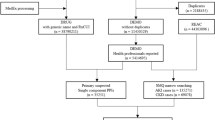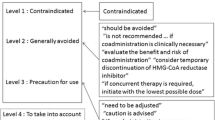Abstract
Background and Objective
While risk of acute kidney injury (AKI) is a well documented adverse effect of some drugs, few studies have assessed the relationship between drug–drug interactions (DDIs) and AKI. Our objective was to develop an algorithm capable of detecting potential signals on this relationship by retrospectively mining data from electronic health records.
Material and methods
Data were extracted from the clinical data warehouse (CDW) of the Hôpital Européen Georges Pompidou (HEGP). AKI was defined as the first level of the RIFLE criteria, that is, an increase ≥50 % of creatinine basis. Algorithm accuracy was tested on 20 single drugs, 10 nephrotoxic and 10 non-nephrotoxic. We then tested 45 pairs of non-nephrotoxic drugs, among the most prescribed at our hospital and representing distinct pharmacological classes for DDIs.
Results
Sensitivity and specificity were 50 % [95 % confidence interval (CI) 23.66–76.34] and 90 % (95 % CI 59.58–98.21), respectively, for single drugs. Our algorithm confirmed a previously identified signal concerning clarithromycin and calcium-channel blockers (unadjusted odds ratio (ORu) 2.92; 95 % CI 1.11–7.69, p = 0.04). Among the 45 drug pairs investigated, we identified a signal concerning 55 patients in association with bromazepam and hydroxyzine (ORu 1.66; 95 % CI 1.23–2.23). This signal was not confirmed after a chart review. Even so, AKI and co-prescription were confirmed for 96 % (95 % CI 88–99) and 88 % (95 % CI 76–94) of these patients, respectively.
Conclusion
Data mining techniques on CDW can foster the detection of adverse drug reactions when drugs are used alone or in combination.



Similar content being viewed by others
References
Hines LE, Murphy JE. Potentially harmful drug-drug interactions in the elderly: a review. Am J Geriatr Pharmacother. 2011;9:364–77.
Pimohamed M. Drug interactions of clinical importance. London: Chapman & Hall; 1998.
Hazell L, Shakir SAW. Under-reporting of adverse drug reactions : a systematic review. Drug Saf. 2006;29:385–96.
Thakrar BT, Grundschober SB, Doessegger L. Detecting signals of drug–drug interactions in a spontaneous reports database. Br J Clin Pharmacol. 2007;64:489–95.
Tatonetti NP, Fernald GH, Altman RB. A novel signal detection algorithm for identifying hidden drug-drug interactions in adverse event reports. J Am Med Inform Assoc. 2012;19:79–85.
Curtis JR, Cheng H, Delzell E, Fram D, Kilgore M, Saag K, et al. Adaptation of Bayesian data mining algorithms to longitudinal claims data: coxib safety as an example. Med Care. 2008;46:969–75.
Wang X, Hripcsak G, Markatou M, Friedman C. Active computerized pharmacovigilance using natural language processing, statistics, and electronic health records: a feasibility study. J Am Med Inform Assoc. 2009;16:328–37.
Svanström H, Callréus T, Hviid A. Temporal data mining for adverse events following immunization in nationwide Danish healthcare databases. Drug Saf. 2010;33:1015–25.
Schuemie MJ. Methods for drug safety signal detection in longitudinal observational databases: LGPS and LEOPARD. Pharmacoepidemiol Drug Saf. 2011;20:292–9.
Coloma PM, Trifirò G, Patadia V, Sturkenboom M. Postmarketing safety surveillance : where does signal detection using electronic healthcare records fit into the big picture? Drug Saf. 2013;36:183–97.
Avillach P, Dufour J-C, Diallo G, Salvo F, Joubert M, Thiessard F, et al. Design and validation of an automated method to detect known adverse drug reactions in MEDLINE: a contribution from the EU–ADR project. J Am Med Inform Assoc [Internet]. 2012. Available from: http://jamia.bmj.com/content/early/2012/11/28/amiajnl-2012-001083. Cited 5 May 2013.
Pouliot Y, Chiang AP, Butte AJ. Predicting adverse drug reactions using publicly available PubChem BioAssay data. Clin Pharmacol Ther. 2011;90:90–9.
Tatonetti NP, Denny JC, Murphy SN, Fernald GH, Krishnan G, Castro V, et al. Detecting drug interactions from adverse-event reports: interaction between paroxetine and pravastatin increases blood glucose levels. Clin Pharmacol Ther. 2011;90:133–42.
Takahashi Y, Nishida Y, Nakayama T, Asai S. Comparative effect of clopidogrel and aspirin versus aspirin alone on laboratory parameters: a retrospective, observational, cohort study. Cardiovasc Diabetol. 2013;12:87.
Mehta RL, Pascual MT, Soroko S, Savage BR, Himmelfarb J, Ikizler TA, et al. Spectrum of acute renal failure in the intensive care unit: the PICARD experience. Kidney Int. 2004;66:1613–21.
Uchino S, Kellum JA, Bellomo R, Doig GS, Morimatsu H, Morgera S, et al. Acute renal failure in critically ill patients: a multinational, multicenter study. JAMA. 2005;294:813–8.
Bellomo R, Ronco C, Kellum JA, Mehta RL, Palevsky P. Acute renal failure—definition, outcome measures, animal models, fluid therapy and information technology needs: the Second International Consensus Conference of the Acute Dialysis Quality Initiative (ADQI) Group. Crit Care. 2004;8:R204–12.
Ricci Z, Cruz DN, Ronco C. Classification and staging of acute kidney injury: beyond the RIFLE and AKIN criteria. Nat Rev Nephrol. 2011;7:201–8.
Ricci Z, Cruz D, Ronco C. The RIFLE criteria and mortality in acute kidney injury: a systematic review. Kidney Int. 2007;73:538–46.
Ostermann M, Chang RWS. Challenges of defining acute kidney injury. QJM. 2011;104:237–43.
Lapi F, Azoulay L, Yin H, Nessim SJ, Suissa S. Concurrent use of diuretics, angiotensin converting enzyme inhibitors, and angiotensin receptor blockers with non-steroidal anti-inflammatory drugs and risk of acute kidney injury: nested case–control study. BMJ. 2013;346:e8525.
Bickel M, Khaykin P, Stephan C, Schmidt K, Buettner M, Amann K, et al. Acute kidney injury caused by tenofovir disoproxil fumarate and diclofenac co-administration. HIV Med. 2013;14:633–8.
Gandhi S, Fleet JL, Bailey DG, McArthur E, Wald R, Rehman F, et al. Calcium-channel blocker-clarithromycin drug interactions and acute kidney injury. JAMA. 2013;310:2544–53.
Yue Z, Shi J, Jiang P, Sun H. Acute kidney injury during concomitant use of valacyclovir and loxoprofen: detecting drug-drug interactions in a spontaneous reporting system. Pharmacoepidemiol Drug Saf. 2014;23(11):1154–9.
Zapletal E, Rodon N, Grabar N, Degoulet P. Methodology of integration of a clinical data warehouse with a clinical information system: the HEGP case. Stud Health Technol Inform. 2010;160:193–7.
Boussadi A, Caruba T, Zapletal E, Sabatier B, Durieux P, Degoulet P. A clinical data warehouse-based process for refining medication orders alerts. J Am Med Inform Assoc [Internet]. 2012. Available from: http://jamia.bmj.com/content/early/2012/04/19/amiajnl-2012-000850. Cited 16 Apr 2013.
Gaião S, Cruz DN. Baseline creatinine to define acute kidney injury: is there any consensus? Nephrol Dial Transplant. 2010;25:3812–4.
Pickering JW, Endre ZH. Back-calculating baseline creatinine with MDRD misclassifies acute kidney injury in the intensive care unit. CJASN. 2010;5:1165–73.
Acknowledgments
Cendrine Baudoin, Eric Zapletal, Antoine Rachas, Abdel-Ali Boussadi, Bastien Rance, Anne-Sophie Jannot, Jean Bouyer, Gilles Chatellier.
Author information
Authors and Affiliations
Corresponding author
Ethics declarations
Funding
No sources of funding were used to assist in the preparation of this study.
Conflicts of interest
Yannick Girardeau, Claire Trivin, Pierre Durieux, Christine Le Beller, Lillo-Le Louet Agnes, Antoine Neuraz, Patrice Degoulet and Paul Avillach have no conflicts of interest that are directly relevant to the contents of this study.
Ethical standards
All persons gave their informed consent prior to their inclusion in the study. We obtained an approval from the institutional review board of our hospital (IRB#00001072 Study #CDW_2013_0004).
Electronic supplementary material
Below is the link to the electronic supplementary material.
Rights and permissions
About this article
Cite this article
Girardeau, Y., Trivin, C., Durieux, P. et al. Detection of Drug–Drug Interactions Inducing Acute Kidney Injury by Electronic Health Records Mining. Drug Saf 38, 799–809 (2015). https://doi.org/10.1007/s40264-015-0311-y
Published:
Issue Date:
DOI: https://doi.org/10.1007/s40264-015-0311-y




